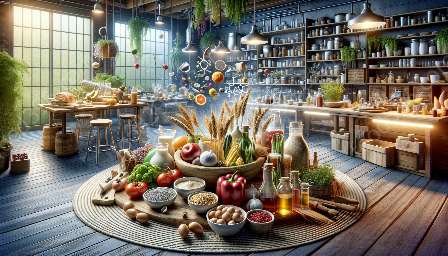Preservatives play a crucial role in the field of food ingredients and culinology, affecting food preservation, safety, and quality. This topic cluster aims to explore the ins and outs of preservatives, their impact on food products, and their compatibility with the principles of culinology.
What Are Preservatives?
Preservatives are substances that are added to food products to prevent spoilage, extend shelf life, and maintain the sensory qualities of the food. They can be natural or synthetic and are used to inhibit the growth of microorganisms, such as bacteria and fungi, that can cause foodborne illness or spoilage.
The Role of Preservatives in Food Ingredients
Preservatives are an integral part of food ingredient formulation, as they help to ensure the safety and quality of the final products. By inhibiting microbial growth, preservatives contribute to the overall stability and shelf life of food items, especially those with long production-to-consumption timelines. Additionally, preservatives can enable manufacturers to distribute their products over wider geographic areas and can reduce food waste by preventing spoilage.
Preservatives and Culinology
In the realm of culinology, the science and art of blending culinary arts and food science, preservatives are a topic of great significance. Culinologists must consider the role of preservatives in creating food formulations that not only taste and look great but also maintain safety and quality over time. Understanding the properties of different preservatives and their interaction with other food ingredients is essential for developing successful, commercially viable food products that meet consumer expectations and regulatory standards.
Natural vs. Synthetic Preservatives
There is an ongoing debate over the use of natural versus synthetic preservatives. Natural preservatives, such as rosemary extract and citric acid, are derived from plants or other natural sources and are often perceived as more desirable by consumers. On the other hand, synthetic preservatives, like sodium benzoate and propylparaben, are chemically manufactured and are subject to scrutiny regarding their potential health effects. Culinologists need to understand the advantages and limitations of both types of preservatives to make informed decisions about ingredient selection and formulation.
Impact on Food Quality
Preservatives can impact various aspects of food quality, such as texture, color, flavor, and nutritional content. It's essential for culinologists to carefully consider the potential effects of preservatives on the sensory attributes and nutritional value of food products. Finding the right balance between preservation and maintaining optimal quality is a critical factor in the successful application of preservatives in food formulations.
Regulatory Considerations
The use of preservatives in food products is subject to strict regulatory oversight to ensure consumer safety. Culinologists and food scientists must stay abreast of the latest regulations and guidelines related to preservatives, including permissible types and levels of use. Compliance with these regulations is crucial for successful product development and commercialization while maintaining consumer trust and safety.
Emerging Trends and Innovations
The field of preservatives is continuously evolving, with a focus on developing new, safer, and more effective preservative solutions. Culinologists are at the forefront of incorporating these emerging technologies and ingredients into their formulations, often driven by consumer demand for cleaner labels and sustainable practices.
Conclusion
Preservatives play a vital role in food ingredients and culinology. The integration of preservatives into food products requires a deep understanding of their impact on food safety, quality, and regulatory compliance. By staying informed about emerging trends and innovations in preservative technology, culinologists can create products that meet consumer expectations while prioritizing safety and quality.

